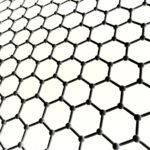
Graphene

Graphene
By the AVICENN team – Last updated July 2022
Many promises…
Synthesized from graphite and revealed to the public in 2004 by André Geim and Konstantin Novoselov at the University of Manchester (England) for which they were awarded the Nobel Prize in 2010, graphene is a nanomaterial often presented as “revolutionary”.
Graphene is made of flat sheet(s) formed by a single thickness of carbon atoms.
It is said to be very light, waterproof, considered chemically inert, transparent, flexible but extremely strong (100 to 300 times stronger than steel) and an excellent conductor of heat and electricity (it is more conductive than copper); these flexible properties are therefore touted as offering multiple possibilities in almost all industrial sectors
… but what are the realities?
Nevertheless, as with other nanomaterials, there may exist a gap between the “promises” of graphene and its actual use1See for example: In French:
–Graphene, the miracle material that could change the face of the world, Les éclaireurs, Canal plus, 25 January 2021
– Will graphene and 2D materials disprove Moore’s Law? Guillaume Fourcadier, Clubic, June 7, 2020
– Le graphène, à un cheveu du miracle?“, L’Express, 5 November 2018
In English:
– Graphene and 2D materials could move electronics beyond ‘Moore’s Law’, University of Manchester, June 3, 2020especially since the manufacturing cost of this material remains extremely high2The cost is all the higher as the number of carbon atom layers is reduced; single- or double-layer graphenes are very difficult to synthesize, manipulate and deposit on substrates – and this remains true for “Few Layer Graphene” (FLG) which have less than a dozen layers..
Some “graphene” players
At the international level, the Graphene Council brings together important graphene manufacturers and the Graphene-info.com portal publishes information on the latest research and applications in this field.
French players include:
- the Isère-based company Graphène Production, created in 2015, which says it produces 90 tons per year of graphene, for all sectors of industry.
- the start-up “Carbon Waters“, created in December 2017 and originating from a CNRS laboratory, which has developed and patented a process for the production of single layer of graphene in water. It is supported by the New Aquitaine Region, the BPI, the TechnoWest incubator and a regional investment fund3Cf. Interview with Alban Chesneau, President of Carbon Waters, Techniques de l’ingénieur, April 25, 2018.
In 2020, a European ISO-G-Scope project was launched to develop harmonized methods for measuring and characterizing graphene.
What about the risks associated with graphene?
In French :
- Graphene: measuring for better control, LNE, date ?
- Graphene / My thesis in 180 seconds, Bastien Marguet, 1st prize, March 2022
- ISO-G-Scope: Harmonizing the characterization of graphene properties, LNE, September 3, 2020
- The super powers of nano-materials, Transition and Energy, January 28, 2020
- ACD Innovation: Graphene water – assets and applications, webinar, May 20, 2019
- Carbone – Ses vies, ses oeuvres, Bernadette Bensaude-Vincent and Sacha Loeve, Seuil, October 2018
- Graphene opens nano windows to separate oxygen from air, Chemistry Research Institute Paris, May 9, 2018
- “Graphene: how to exploit this exceptional material in industry?” and “Can graphene make polymer materials smart?”, M2i conferences, May 30-31, 2018
- Graphene, the nanomaterial of the future?, NanoResp, February 7, 2018
- European Commission selects Graphene flagship research project, CNRS press release, January 28, 2013
In English:
-
What does “graphene” really look like and why is it not “carbon nanotubes”, EUON, 18 January 2022
- The importance of international standards for the graphene community, Clifford CA et al, Nature Reviews Physics, March 2021
- Graphene – Families, properties, applications and production methods, Alban Chesneau, Techniques de l’ingénieur, 10 October 2020
- Graphene-Enabled Adaptive Infrared Textiles, M. Said Ergoktas et al, Nano Letters, June 18, 2020
- Flaghsip Graphene
- World’s first graphene sports shoes unveiled, Nano Magazine, June 2018
Any questions or comments? This information sheet compiled by AVICENN is intended to be completed and updated. Please feel free to contribute.
Our information sheets to go further
Upcoming Nano Agenda

- Scientific conference
- 23rd International conference on Advanced Nanomaterials
- From July 23 to July 25, 2025
- Website: www.advanced-nanomaterials-conference.com

- E-learning program: awareness-raising for personnel who come into contact with nanomaterials during research, formulation, production, maintenance, cleaning, upkeep, etc., as well as safety coordinators or engineers, facility managers, heads of laboratories where nanoparticles are handled.
- Organizers: INSTN Grenoble (CEA)
- On the program:
- 1 – Introduction, definition and characteristics of nanomaterials
- 2 – Toxicity of nanomaterials: the state of knowledge
- 3 – Metrology and characterization of nanomaterials
- 4 – Prevention and protection against nanomaterials in the workplace
- 5 – Quiz: assessment of learning outcomes
- The 2-hour course can be viewed for one month from the date of registration.
- Website: https://instn.cea.fr/…risques-lies-aux-nanomateriaux…

- 10th International Conference on Nanoscience and Technology
- Organized by: Chinese Academy of Sciences and Chinese National Center for Nanoscience and Technology
- Website: http://www.chinanano.org.cn/en/
File initially put on line in June 2016
Notes and references
- 1See for example: In French:
–Graphene, the miracle material that could change the face of the world, Les éclaireurs, Canal plus, 25 January 2021
– Will graphene and 2D materials disprove Moore’s Law? Guillaume Fourcadier, Clubic, June 7, 2020
– Le graphène, à un cheveu du miracle?“, L’Express, 5 November 2018
In English:
– Graphene and 2D materials could move electronics beyond ‘Moore’s Law’, University of Manchester, June 3, 2020 - 2The cost is all the higher as the number of carbon atom layers is reduced; single- or double-layer graphenes are very difficult to synthesize, manipulate and deposit on substrates – and this remains true for “Few Layer Graphene” (FLG) which have less than a dozen layers.
- 3Cf. Interview with Alban Chesneau, President of Carbon Waters, Techniques de l’ingénieur, April 25, 2018






